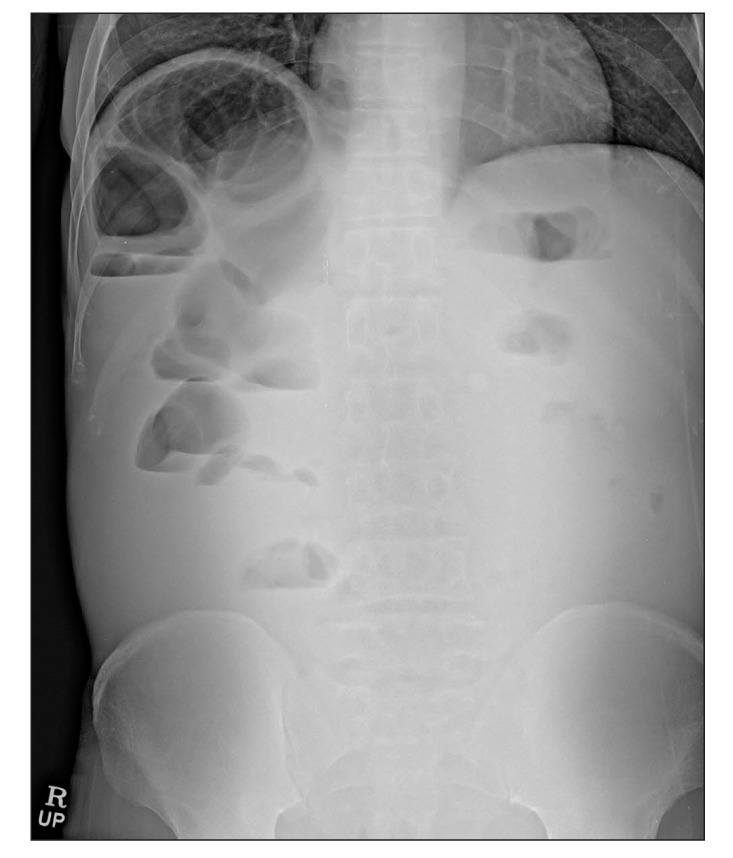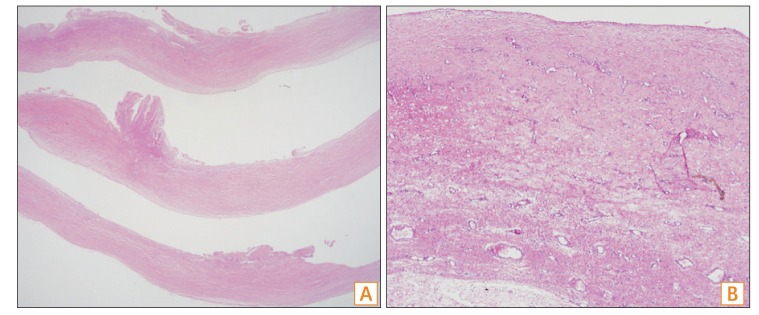Intest Res.
2016 Oct;14(4):375-378. 10.5217/ir.2016.14.4.375.
Sclerosing encapsulating peritonitis in a long-term propranolol user
- Affiliations
-
- 1Department of Gastroenterology, Asan Medical Center, University of Ulsan College of Medicine, Seoul, Korea. bdye@amc.seoul.kr
- 2Inflammatory Bowel Disease Center, Asan Medical Center, University of Ulsan College of Medicine, Seoul, Korea.
- 3Department of Colon & Rectal Surgery, Asan Medical Center, University of Ulsan College of Medicine, Seoul, Korea.
- KMID: 2354957
- DOI: http://doi.org/10.5217/ir.2016.14.4.375
Abstract
- Sclerosing encapsulating peritonitis (SEP) is a rare cause of bowel obstruction that is characterized by the encasement of the small bowel by a thick, whitish, and fibrous membrane. The pathophysiology of SEP is poorly understood and preoperative diagnosis is difficult. Previous reports suggest that SEP may be linked to the chronic use of β-adrenergic blockers. A 46-year-old man with liver cirrhosis and end-stage renal disease on hemodialysis presented with recurrent abdominal pain and borborygmi. He had been taking propranolol to prevent bleeding from gastroesophageal varices for the past 15 years. Abdominal computed tomography showed ileal loops encapsulated by soft tissue with dilatation of the proximal small bowel on the right side of the abdomen. Barium follow-through showed conglomerated distal ileal loops with a cauliflower-like appearance. Explorative laparotomy revealed a thick, fibrous, whitish capsule encapsulating the ileal loops. The covering membrane was dissected and excised, resulting in an improvement in symptoms after surgery. Accordingly, a final diagnosis of SEP was made. Due to the lack of other apparent causes for SEP, we conclude that in this case, the long-term use of propranolol may be associated with the development of SEP.
Keyword
MeSH Terms
Figure
Reference
-
1. Owtschinnikow P. Peritonitis chronica fibrosa incapsulata. Arch Klin Chir. 1907; 83:623–634.2. Foo KT, Ng KC, Rauff A, Foong WC, Sinniah R. Unusual small intestinal obstruction in adolescent girls: the abdominal cocoon. Br J Surg. 1978; 65:427–430. PMID: 656764.
Article3. Sieck JO, Cowgill R, Larkworthy W. Peritoneal encapsulation and abdominal cocoon: case reports and a review of the literature. Gastroenterology. 1983; 84:1597–1601. PMID: 6840491.4. Bradley JA, McWhinnie DL, Hamilton DN, et al. Sclerosing obstructive peritonitis after continuous ambulatory peritoneal dialysis. Lancet. 1983; 2:113–114.
Article5. Holland P. Sclerosing encapsulating peritonitis in chronic ambulatory peritoneal dialysis. Clin Radiol. 1990; 41:19–23. PMID: 2404649.
Article6. Kalra S, Atia A, McKinney J, Borthwick TR, Smalligan RD. Sclerosing encapsulating peritonitis associated with propranolol usage: a case report and review of the literature. J Dig Dis. 2009; 10:332–335. PMID: 19906115.
Article7. Kaushik R, Punia RP, Mohan H, Attri AK. Tuberculous abdominal cocoon: a report of 6 cases and review of the Literature. World J Emerg Surg. 2006; 1:18. PMID: 16800898.8. Brown P, Baddeley H, Read AE, Davies JD, McGarry J. Sclerosing peritonitis, an unusual reaction to a beta-adrenergic-blocking drug (practolol). Lancet. 1974; 2:1477–1481. PMID: 4140395.9. Baxter-Smith DC, Monypenny IJ, Dorricott NJ. Sclerosing peritonitis in patient on timolol. Lancet. 1978; 2:149.10. Harty RF. Sclerosing peritonitis and propranolol. Arch Intern Med. 1978; 138:1424–1426. PMID: 150826.
Article11. Ahmad S. Sclerosing peritonitis and propranolol. Chest. 1981; 79:361–362. PMID: 6970657.
Article12. Clark CV, Terris R. Sclerosing peritonitis associated with metoprolol. Lancet. 1983; 1:937.
Article13. Grefberg N, Nilsson P, Andreen T, et al. Sclerosing obstructive peritonitis, beta-blockers, and continuous ambulatory peritoneal dialysis. Lancet. 1983; 322:733–734.
Article14. Stanley MM, Reyes CV, Greenlee HB, Nemchausky B, Reinhardt GF. Peritoneal fibrosis in cirrhotics treated with peritoneovenous shunting for ascites: an autopsy study with clinical correlations. Dig Dis Sci. 1996; 41:571–577. PMID: 8617138.
Article15. Maguire D, Srinivasan P, O'Grady J, Rela M, Heaton ND. Sclerosing encapsulating peritonitis after orthotopic liver transplantation. Am J Surg. 2001; 182:151–154. PMID: 11574087.
Article16. Ngô Y, Messing B, Marteau P, et al. Peritoneal sarcoidosis: an unrecognized cause of sclerosing peritonitis. Dig Dis Sci. 1992; 37:1776–1780. PMID: 1425080.17. Berg RA, Moss J, Baum BJ, Crystal RG. Regulation of collagen production by the beta-adrenergic system. J Clin Invest. 1981; 67:1457–1462. PMID: 6262376.18. Hur J, Kim KW, Park MS, Yu JS. Abdominal cocoon: preoperative diagnostic clues from radiologic imaging with pathologic correlation. AJR Am J Roentgenol. 2004; 182:639–641. PMID: 14975962.
Article
- Full Text Links
- Actions
-
Cited
- CITED
-
- Close
- Share
- Similar articles
-
- Sclerosing Encapsulating Peritonitis in Chronic Ambulatory Peritoneal Dialysis; Preoperative Catheter Drainage: A Case Report
- Successful Treatment of Sclerosing Encapsulating Peritonitis with Tamoxifen and Prednisolone
- Ultrasonographic Findings of Sclerosing Encapsulating Peritonitis
- Unusual intestinal obstruction due to idiopathic sclerosing encapsulating peritonitis: a report of two cases and a review
- Two Cases of Resection of Localized Sclerosing Encapsulating Peritonitis






